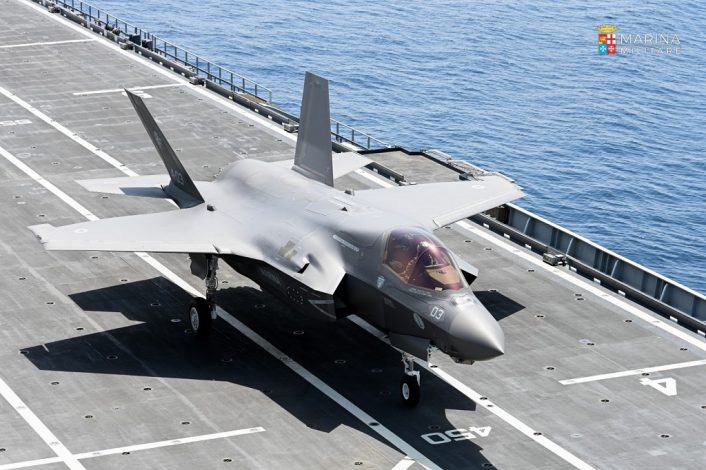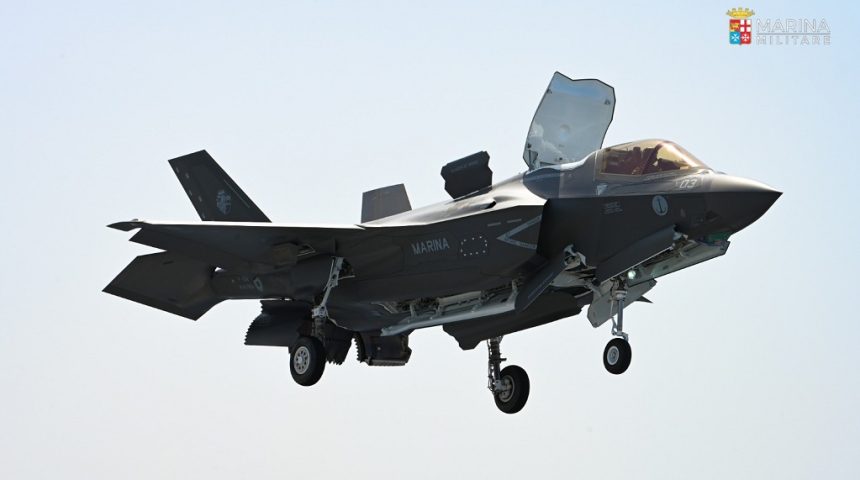The historic event follows the recent delivery of the third F-35B to the Italian Navy and the Ready for Operations test campaign in the USA earlier this year.
An Italian F-35B Lightning II, belonging to the Marina Militare (Italian Navy) landed on the Italian Navy’s ITS Cavour aircraft carrier for the first time on July 30, 2021 during navigation in the Gulf of Taranto. The aircraft is the BL-4 built at the Cameri Final Assembly and Check Out (FACO), in northwestern Italy, and recently delivered with the serial MM7454 and codes “4-03”, which flew for the first time in June. As the other two F-35Bs delivered to the Navy, it features the wolf’s head insignia on the tail, the wolf’s paw prints on the rudder, the Italian Navy roundel and the “MARINA” text.
“Today we are witnessing the landing on the Cavour aircraft carrier of the first F-35 of the Italian Navy: [it is] a great step towards the strategic objective of providing the Defense and Italy with an aircraft carrier capability with the latest generation of aircraft on board. A capacity that projects us into an elite of a few countries in the world, thus raising the level and international weight of Italy ”, said the Chief of Staff of the Navy, Admiral Giuseppe Cavo Dragone.
#30luglio: Verde al Ponte! il primo F-35 della #MarinaMilitare è appontato #Oggi a bordo della Portaerei Cavour, con l’unità in navigazione nel Golfo di #Taranto.
Comunicato stampa nr. 58 ► https://t.co/Ijk819hYtB#NoiSiamolaMarina #ProfessionistidelMare #AviazioneNavale pic.twitter.com/XcRpJotuN3
— Marina Militare (@ItalianNavy) July 30, 2021
An Italian F-35B landed for the first time on the ITS Cavour aircraft carrier. The important milestone comes as the #MarinaMilitare prepares to celebrate 30 years of naval aviation since the AV-8B+ Harrier entered service in 1991. Video courtesy of the Italian Navy pic.twitter.com/cBQUxNBA5e
— Stefano D’Urso (@stedur93) July 31, 2021
The delivery of the new aircraft has been defined as an important milestone in the process that will replace the aging AV-8B+ Harrier with the new 5th gen aircraft on the ITS Cavour and, in future, the new ITS Trieste. The Marina Militare expects to reach the Initial Operational Capability (IOC) with the F-35B by 2024 and the Final Operational Capability (FOC) as soon as the deliveries are completed.
Initially it was not clear where the F-35B BL-4 would be assigned, as the first two jets are in the United States to train pilots at MCAS Beaufort. However, the Navy mentioned in the press release that the arrival of this new aircraft allows the naval service to begin the training of pilots for their Carrier Qualification (CQ) on Italian ships: it seems safe to believe that it will stay in Italy (at least for the moment), but it is not known if it will be based at Grottaglie airport with the Harriers or at Amendola Air Base with the Italian Air Force F-35s to reduce the logistical burden until the final decision for the Navy’s F-35 basing is confirmed.

The decision about the base for the Navy’s F-35Bs and the delivery of 15 jets to the Navy and 15 to the Air Force have been a much debated topic in Italy, as we often reported here at The Aviationist. Here is an extract of what we wrote last year when the Air Force received its first F-35B:
The Gruppo Aerei Imbarcati, which will operate the F-35B within the Navy, is currently based in Grottaglie, close to the naval port of Taranto, home to the Cavour aircraft carrier [and to the Trieste landing helicopter dock (LHD), in the future]. However, according to some reports, the Italian Defense Chief of Staff has already identified Amendola Air Base, the MOB (Main Operating Base) of the F-35A within the ItAF (about 100NM northwest of Grottaglie), as the national MOB for both the CTOL (Convetional Take Off and Landing) and STOVL (Short Take Off Vertical Landing) versions of the Lightning II. This should prompt the relocation of the “Wolves” to Amendola, creating a joint Air Force/Navy flight line with common logistics and training, even though it would practically mean that the entire force would mostly be under Air Force control.
With both Italian Air Force’s and Navy’s F-35Bs based at Amendola AB, the Italians would replicate the British model that sees RAF Marham as MOB for a jointly manned “Lightning Force” made of Air Force (with the 207 and 617 squadrons) and Navy (with the 809 Naval Air Squadron that will be re-established in 2023) personnel, sharing aircraft, equipment and support infrastructures. The creation of an Italian Joint Lightning Force makes much sense: aircrew training, maintenance and at least part of the logistics could be concentrated in one place, with some significant savings. And if the selected base is Amendola, the Italian Joint Force could leverage at least some of the infrastructures built there to accommodate the Lightning. Indeed, preparation to host the F-35 in Amendola started in 2012 and today the “F-35 citadel” is literally a “base inside the base” with modern shelters and buildings located inside an access-controlled restricted zone created to isolate the 13° Gruppo’s area from the rest of the base. It must not be forgotten tha the advent of the F-35 has induced the Italian MoD to adopt tighter security measures than those in place before the arrival of a 5th generation technology and this becomes pretty evident if you think that all the photographs taken inside Amendola, must be reviewed one by one by security personnel so that no sensitive detail would be leaked. For sure, making Grottaglie ready for the F-35B would cost a lot of money and time, considered that the works to prepare the base for the Joint Strike Fighter were halted a couple of years ago.
In a post about the F-35B and the use of the aircraft as part of an Italian Joint Lightning Force published here at The Aviationist about 10 years ago our Editor David Cenciotti wrote:
“I don’t know if Italy is ready for a single type of aircraft for both ItAF and ItNy, capable of operating from the Cavour aircraft carrier as a single unit, something that would logically lead to the creation of a joint force similar to the British Joint Force Harrier and to the subsequent proposal of reabsorbing the unit into the Air Force, an option that the Navy might not accept….”
A decade later, the situation has probably not changed much.
In fact, while the final decision about the basing might still be uncertain, there is no doubt that the assignment of the third F-35B to the Air Force has made the Navy not happy. Navy officials have long challenged the decision of the Italian Air Force to procure the F-35B. The Italian Air Force considers the STOVL variant of the stealth aircraft indispensable for expeditionary scenarios and operations from unimproved and short landing strips.
#MarinaMilitare appontaggio del primo F-35B sulla portaerei Cavour: dal 1991, anno di ingresso della linea AV8B+ Harrier su #naveGaribaldi, ad oggi con l’F-35B su #naveCavour, l’#AviazioneNavale in continua evoluzione.#NoisiamolaMarina #UnMarediOpportunità @SM_Difesa pic.twitter.com/XDpQYq4O1d
— Marina Militare (@ItalianNavy) July 31, 2021
Now, back to our main topic. The first landing of an Italian Navy F-35B on the ITS Cavour follows the “Ready for Operation” compatibility testing in the United States earlier this year, when two specially-instrumented U.S. F-35Bs belonging to VX-23 (Air Test and Evaluation Squadron 23) from Naval Air Station Patuxent River (NAS Pax River) were deployed on the ship to test every aspect of the 5th gen aircraft operations onboard.
As part of the sea trials, the two F-35Bs of VX-23 carried out more than 50 flight missions, in all weather and sea state conditions, a night session, around 120 vertical landings, and as many short take-offs with the aid of the ski jump, and finally a vertical take-off test. Based on the images released during the campaign, some tests were also conducted with external loads, a configuration often referred to as “Beast Mode”.
These milestones come just as Navy prepares to celebrate the 30th anniversary of the first Harrier landing on the ITS Garibaldi (the ITS Cavour predecessor) at the end of August. However, this is the only important anniversary this year, as 2021 also marks the 160th anniversary of the Marina Militare, the 10th anniversary of the ITS Cavour becoming the fleet’s flagship (replacing the ITS Garibaldi) and the 30th anniversary of the Gruppo Aerei Imbarcati “Wolves” (which operates the Harrier and, in future, the Lightning II).









